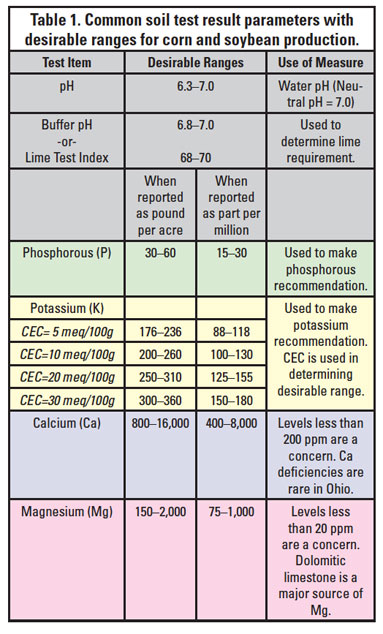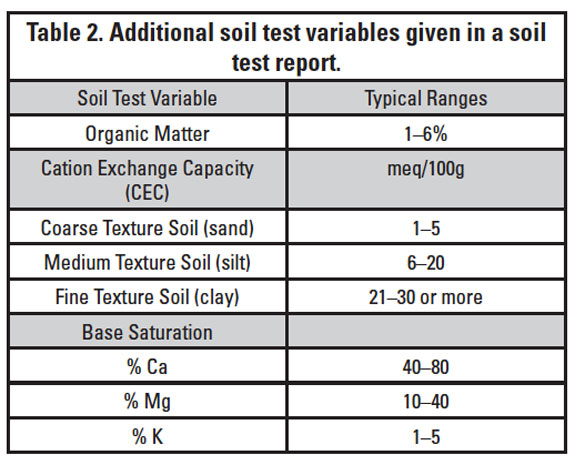Other useful measures on the report, such as cation exchange capacity (CEC), organic matter and base saturation, further define soil factors related to nutrient availability and holding capacity that should be considered as nutrient plans are developed.

Desirable ranges to maximize crop production for each of the tests performed in a standard soil test are listed in Table 1.
This table should serve as a general guideline to help determine if your soil is within the desirable range for each of the parameters tested.
Soil pH and buffer pH
The level of active soil acidity is measured using soil pH. A pH value above 7.0 is alkaline; a value below 7.0 is acidic. A pH value of 7.0 is neutral.
LTI or buffer pH is an indicator of the reserve (potential) acidity in the soil and is used to determine the quantity of lime needed to correct the pH of an acidic soil.
Limestone parent materials found in western and northwestern Ohio may have a subsoil pH that is greater than 7.0 and contain as much as 50% calcium carbonate or its equivalent.
Eastern and southeastern Ohio soils, developed mainly from sandstones and shale and subsoil, may have pH values as low as 5.0.
Phosphorus, potassium, calcium and magnesium
Soil test values may be reported in parts per million (ppm) or pounds per acre (lb/ac). To convert from ppm to lbs per acre, multiply ppm by two.
Phosphorus, potassium, calcium and magnesium soil test values are indicators of the relative available nutrient levels in the soil and not equal to the total amounts of these nutrients available in the soil for plant uptake.
Phosphorus and potassium soil test values are correlated with crop yield response and fertilizer needs (i.e., as the soil test value increases, the need for supplemental fertilizer decreases).
Soil organic matter, CEC and base saturation are other variables that are shown on the soil test report to quantify soil characteristics and help understand other qualitative factors associated with the area represented by the sample.

Typical ranges for organic matter, CEC, and base saturation are shown in Table 2.
Organic matter
Tillage, parent material, crop productivity and other management factors influence soil organic matter. Organic matter is important in nutrient holding capacity.
Cation exchange capacity (CEC)
CEC measures the capacity of the soil to hold exchangeable cations (positively charged ions) and is reported as meq/100g of soil (meq = milliequivalents). Reports may also be reported as cmolc/kg of soil (cmolc = centimoles of charge).
One cmolc/kg is equal to one meq/100 g.Exchangeable cations include aluminum, hydrogen, calcium, magnesium, and potassium. The CEC depends largely on the amount and type of clay and the organic matter content.
The higher the CEC value, the more cations the soil is able to hold, reducing the likelihood of leaching. It is not practical to attempt to increase the CEC of a soil by adding clay or organic matter. Liming an acid soil will slightly increase the effective CEC.
Base saturation: Percentage of calcium, percentage of magnesium and percentage of potassium
Base saturation is the extent to which the adsorption complex of a soil is saturated with exchangeable cations other than hydrogen or aluminum. It is expressed as a percentage of the total CEC. The calcium to magnesium ratio is calculated on the basis of percentage saturation of the soil CEC by both elements. This ratio should be considered when lime is added to the soil.
If the Ca:Mg ratio is 1:1 or less (less Ca than Mg), a lower percentage magnesium limestone should be used. Agronomic crops grow over a wide range of ratios with the ideal ratio being about 6:1 to 10:1.
The magnesium to potassium ratio should be greater than 2:1. In other words, the percent base saturation of Mg should be at least two times the percent base saturation of K. High K frequently results in reduced uptake of Mg by plants.
Therefore, to help prevent plant nutrient imbalance, additional Mg may be required to maintain an Mg:K ratio of at least 2:1. The greatest concern with this ratio is for grass hay production where forage produced on a field with less than 2:1 Mg:K ratio can result in grass tetany conditions. FG
—From The Ohio State University Extension Agriculture and Natural Resources Fact Sheet









